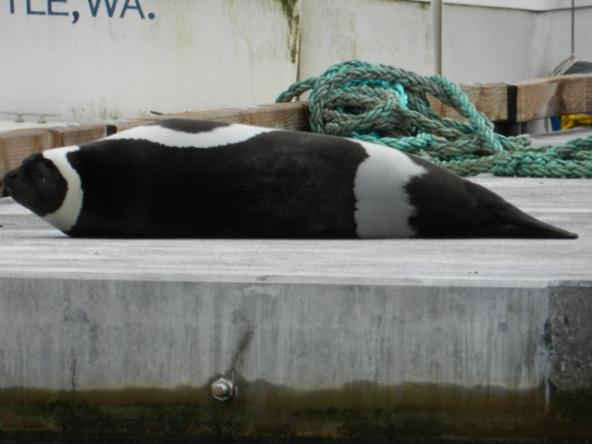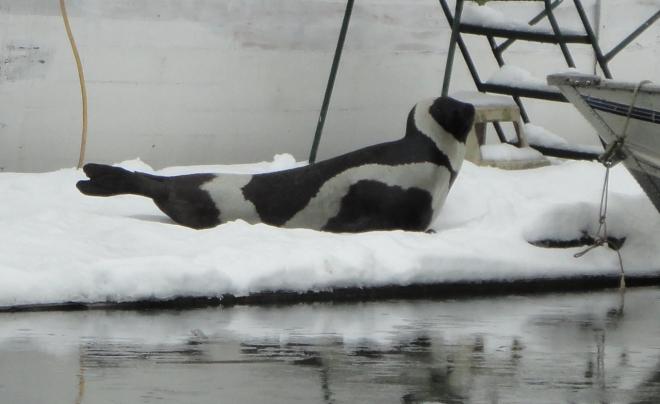Ribbon seals in the Salish Sea?
Can Puget Sound claim a new species? Ribbon seals were not previously thought to venture into the Salish Sea, but a series of sightings in Puget Sound in 2012 expands their potential range. Scientists are keeping an eye out for future sightings.
Local sighting of a Ribbon seal:
Ribbon seals (Histriophoca fasciata) inhabit the waters of the Arctic and Subarctic polar regions, and are not considered inhabitants of the Salish Sea (Gaydos and Pearson, 2011). Most commonly sighted in the Bering and Okhotsk Seas, Ribbon seals also have been observed in the Arctic Ocean, which includes the Chukchi, Eastern Siberian, and the Western Beaufort Seas. A Ribbon seal, however, was sighted in the Salish Sea in January 11, 2012 when a private citizen noticed a strange looking seal on a dock on the Duwamish River in Seattle and reported it the following day to NOAA’s Northwest Marine Mammal Stranding Network (Fig.1). Using photographs, the sighting was confirmed to be a Ribbon seal. The seal was sighted again in Snohomish County on January 20th, 2012 (Fig. 2). It was sighted again in Steamboat Slough in Everett, Washington on January 31st.
A team of biologists from NOAA’s Alaska Fisheries Science Center, the National Marine Mammal Laboratory, and NOAA Fisheries Northwest Regional Office with the help of a veterinarian from PAWS Wildlife captured the animal and conducted a health assessment. It was an adult male and weighed 75.5 kg and was 139.7 cm long. While there was interest in putting a satellite transmitter on the Ribbon seal to track its movements, it was decided to limit handling time and focus efforts on collecting critical samples to evaluate the seal’s health. The seal was re-sighted occasionally in Washington State and British Columbia through July 2012. Future sightings of Ribbon seals in the Salish Sea should be reported to NOAA Fisheries in the US (866-767-6114) or Department of Fisheries and Oceans in Canada (866-567-6277).
Physical description:
Ribbon seals exhibit little sexual dimorphism. Adult Ribbon seals measure approximately 1.5 m (straight length), and weigh between 90 – 148 kg. Ribbon seals from the southern part of the Okhotsk Sea tend to be slightly longer and heavier than those living elsewhere. Pups are born with a coat of white fur, which they shed after five weeks of lactation. Soon after their first year, juvenile Ribbon seals develop their characteristically dark body fur and light white banding which encircles the neck, each front flipper, and the hips. These light bands become increasingly bright up until the second year. Males generally have darker bodies than the female Ribbon seals. Individual ribbon seals can live for 20-25 years (Nowack, 1999).
Habitat:
Ribbon seals are typically found in the North Pacific, primarily in the Bering and Okhotsk Seas, and seasonally in the Chukchi Sea, and Western Beaufort Sea and the Northern Sea of Japan. The most recent total worldwide population estimate was 240,000 based on surveys conducted in the mid 1970’s (Allen and Angliss, 2009). Ribbon seals have not been hunted commercially for several decades, and it is thought that as a consequence of these international conservation efforts, their population has nearly returned to pre-exploitation levels (Allen and Angliss, 2009).
Diet:
The Ribbon seal’s diet varies depending on their age and the time of the year but typically consists of pelagic fish like Cod (Gadus macrocephalus), Pollack (P. pollachius) and Capelin (Mallotus villosus), as well as invertebrates, including shrimp (Caridea sp.), crabs (Brachyura sp.), squid (Teuthida sp.), and octopus (Octopoda sp.) (Nowack, 1999).
Current Legal Status:
In March 2008 the United States reviewed the Ribbon seal for potential listing under the U.S. Endangered Species Act. Despite concern about potential habitat loss due to global climate change, it was determined that there was insufficient data to list the species as endangered (U.S. Federal Register, 2013).
Literature Cited:
Allen, B. M., and R. P. Angliss. 2009. Ribbon seal (Histriophoca fasciata): Alaska Stock. In Alaska Marine Mammal Stock Assessments Pp. 64-68. NOAA Technical Memo AFS-206.
Gaydos, J. K., and S. Pearson. 2011. Bird and Mammals that Depend on the Salish Sea: a compilation. Northwestern Naturalist 92:79-89.
Nowack, R. M. 1999. Pinnipedia: Phocidae. In Walker’s Mammals of the World. Volume 2, John Hopkins University Press, Baltimore, Maryland. Pp. 894-895.
U.S. Federal Register. 2013. Determination on whether to list the Ribbon seal as a threatened or endangered species. 78 FR 41371 Pp. 41371-41384. Available at: https://federalregister.gov/a/2013-16601







